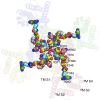C-type inactivation of voltage-gated K+ channels: pore constriction or dilation?
- PMID: 23319730
- PMCID: PMC3557304
- DOI: 10.1085/jgp.201210888
C-type inactivation of voltage-gated K+ channels: pore constriction or dilation?
Figures




Similar articles
-
A structural interpretation of voltage-gated potassium channel inactivation.Prog Biophys Mol Biol. 2006 Oct;92(2):185-208. doi: 10.1016/j.pbiomolbio.2005.10.001. Epub 2005 Nov 8. Prog Biophys Mol Biol. 2006. PMID: 16316679 Review.
-
Constitutive inactivation of the hKv1.5 mutant channel, H463G, in K+-free solutions at physiological pH.Cell Biochem Biophys. 2005;43(2):221-30. doi: 10.1385/CBB:43:2:221. Cell Biochem Biophys. 2005. PMID: 16049347
-
Voltage-gated ion channels.Curr Biol. 2005 Jan 26;15(2):R44-7. doi: 10.1016/j.cub.2004.12.050. Curr Biol. 2005. PMID: 15668152 Review. No abstract available.
-
The HERG K+ channel: progress in understanding the molecular basis of its unusual gating kinetics.Eur Biophys J. 2004 Apr;33(2):89-97. doi: 10.1007/s00249-003-0338-3. Epub 2003 Sep 10. Eur Biophys J. 2004. PMID: 13680209 Review.
-
Models of the structure and voltage-gating mechanism of the shaker K+ channel.Biophys J. 2004 Oct;87(4):2116-30. doi: 10.1529/biophysj.104.040618. Biophys J. 2004. PMID: 15454416 Free PMC article.
Cited by
-
Exploring the Dynamics of the TWIK-1 Channel.Biophys J. 2016 Aug 23;111(4):775-784. doi: 10.1016/j.bpj.2016.07.009. Biophys J. 2016. PMID: 27558721 Free PMC article.
-
Pore helices play a dynamic role as integrators of domain motion during Kv11.1 channel inactivation gating.J Biol Chem. 2013 Apr 19;288(16):11482-91. doi: 10.1074/jbc.M113.461442. Epub 2013 Mar 7. J Biol Chem. 2013. PMID: 23471968 Free PMC article.
-
Marine Toxins Targeting Kv1 Channels: Pharmacological Tools and Therapeutic Scaffolds.Mar Drugs. 2020 Mar 20;18(3):173. doi: 10.3390/md18030173. Mar Drugs. 2020. PMID: 32245015 Free PMC article. Review.
-
A perspective on Na and K channel inactivation.J Gen Physiol. 2018 Jan 2;150(1):7-18. doi: 10.1085/jgp.201711835. Epub 2017 Dec 12. J Gen Physiol. 2018. PMID: 29233885 Free PMC article. Review.
-
Molecular basis of PIP2-dependent regulation of the Ca2+-activated chloride channel TMEM16A.Nat Commun. 2019 Aug 21;10(1):3769. doi: 10.1038/s41467-019-11784-8. Nat Commun. 2019. PMID: 31434906 Free PMC article.
References
Publication types
MeSH terms
Substances
Grants and funding
LinkOut - more resources
Full Text Sources
Other Literature Sources
Medical

